Cryptocurrency can be a wild world where fortunes can easily be lost or made in a blink of an eye. Security and putting together a foolproof strategy are both essential. If you're stepping into this thrilling space, one of the first things you'll need is a reliable wallet to store your digital treasures. How can you select the right wallet from so many choices for storing and managing your digital assets? Security, ease of use, and a wide range of features are all essential — but can one wallet really offer it all?
Enter Coinbase Wallet. This is a popular option in the crypto world. What does Coinbase have to offer and is this the best way to keep your assets safe, while still allowing you the freedom to explore all that the crypto space has to offer? Is it as good as its reputation or are there other options?
We’ll examine its strengths and weaknesses, as well as its features and capabilities, in this Coinbase Wallet evaluation.
Coinbase Wallet Review Summary
Coinbase Wallet provides a safe, easy-to-use platform for storing cryptocurrencies and other digital assets. The Coinbase Wallet offers features for both new and seasoned crypto-users. These include non-custodial storage of private keys, seamless integration with Coinbase’s ecosystem, support for DApps, and seamless integration into the Coinbase ecosphere. While it excels at ease of use and safety, it may not have all the advanced features that other wallets offer.
Coinbase Wallet’s Key Features Include:
• Non-custodial walletControl of all private keys stored on your device.
• Security that is robustFor added security, use biometric authentication, a secure enclave and encrypted backups.
• Supported assets are available in a wide rangeSupports Bitcoins, Ethereums, ERC-20 Tokens and many more.
• dApp access and DeFiEasy integration with financial platforms and applications.
• NFT supportWallet allows you to store, manage and view NFTs.
• Coinbase integration seamlessTransferring assets between Coinbase Wallet accounts and Coinbase Exchange accounts is easy.
• Interface that is easy to useDesign that is intuitive for both novices and experienced users.
• Ledger integrationSecurity enhanced with compatibility with Ledger Hardware Wallets
What is Coinbase?
Coinbase is the largest name in the world’s cryptocurrency exchanges. This platform was founded in 2012 by Brian Armstrong, Fred Ehrsam and started as a place to simply buy and sell Bitcoin. Coinbase, like a tech-savvy Phoenix, quickly expanded its services to include an array of other options. What’s the goal? Create an open financial system to which anyone, anywhere can have access.
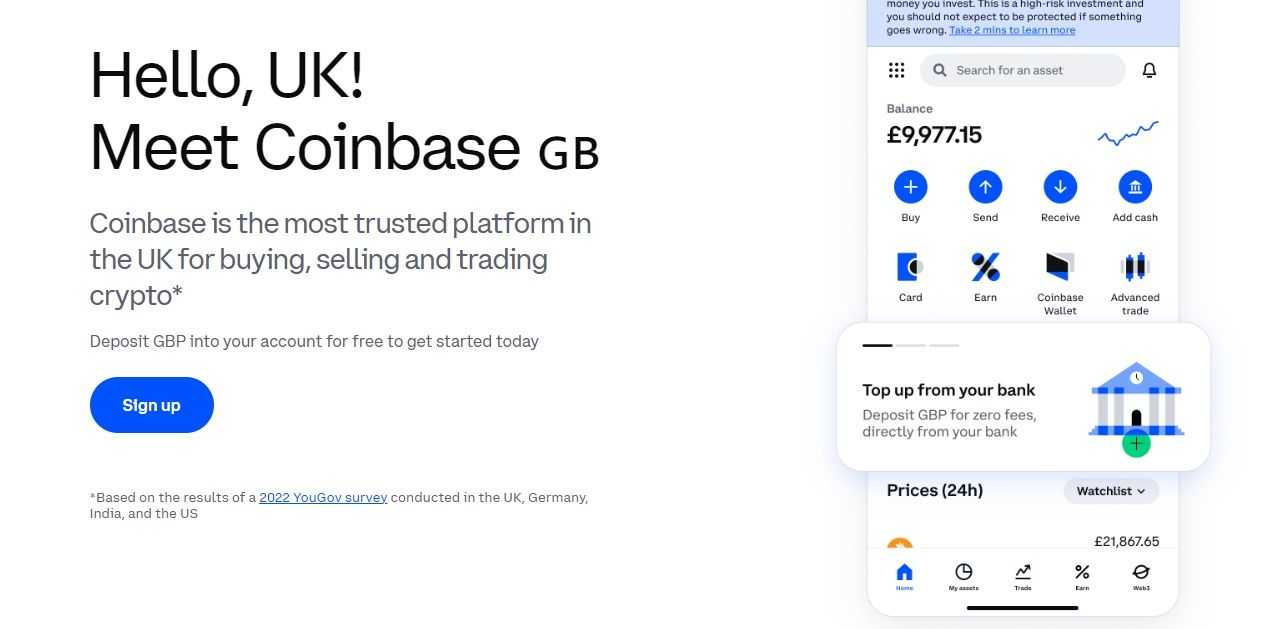
Coinbase, a San Francisco-based company that embraces a remote first model, embodies the decentralized spirit behind blockchain technology. Coinbase made headlines on Wall Street and in the crypto community when it went public, April 2021. The company listed on NASDAQ with the ticker code COIN.
What is Coinbase? There’s something for everyone. For beginners, there's the super intuitive platform that makes buying and selling crypto as easy as ordering a pizza. For more experienced traders, Coinbase Advanced Exchange has all the tools they need and lower fees for serious trading. Coinbase Prime, designed for large players, offers margin finance and OTC services, as well as high-volume options.
The only publicly traded crypto-exchange in the U.S. is a company that adheres to rigorous regulations, employs robust security, and offers insurance as well as two-factor verification.
You can find out more by reading our complete Coinbase review. Did you also know Coinbase offers a second layer, Base? Visit our Base review. Once you're done with that, you can check out the best Base wallets and the best Base DApps.
What is Coinbase Wallet?
Coinbase wallet is not the main Coinbase exchange where you can trade and purchase crypto. It’s your personal safe. It’s a non-custodial wallet, meaning you — and only you — have the keys to your crypto castle.
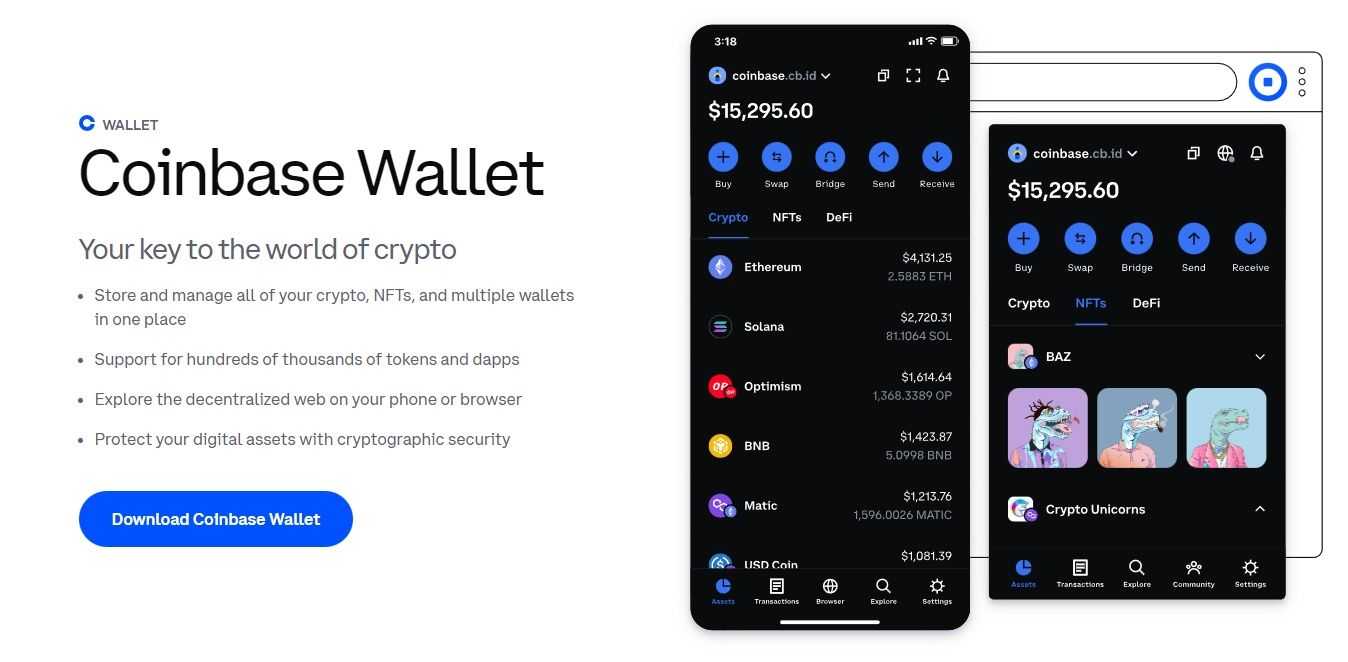
What makes Coinbase Wallet unique? The first thing is that you have full control. Your private keys will be stored on your device. This setup is ideal if you’re the type who likes to be in the driver's seat when it comes to your digital assets. The wallet also supports many different cryptocurrencies. Coinbase Wallet can handle all your needs, whether you’re interested in Bitcoin, Ethereum, ERC-20 tokens or a combination of both.
And it's not just about storage. The Coinbase Wallet lets you explore the exciting world of decentralized applications (DApps) and even dip your toes into decentralized finance (DeFi) — right from your phone. You might be interested in swapping tokens, participating in blockchain games or lending your crypto to earn interest. This wallet will handle all of your needs.
The wallet is also easy to use, so it’s perfect for both crypto beginners and experts. Coinbase Wallet offers features that will help those concerned about security.
And here's a cherry on top: the Coinbase Wallet works seamlessly with your Coinbase account. Want to purchase some crypto on Coinbase, and then store it safely in your wallet afterwards? It’s no problem! Transferring assets between the two is as easy as a couple of taps.
How to Install Coinbase Wallet
Setting up the Coinbase Wallet is like setting up a new phone — you just follow a few simple steps, and you’re ready to explore the world of crypto. This step-by-step tutorial will guide you through the process.
1. Download the Coinbase Wallet AppThe app is the first thing you’ll need. Go to Google Play or the App store if you are using an Android. You can search for “Coinbase Wallet” Download. You’re already halfway there.
2. Open the app and create a new walletOpen the app after it has been installed. When you open the app, there are a few options. Since we’re just starting out, choose “Create a New Wallet."
3. Secure Your Wallet with a Passcode or Biometric Lock: Security is key — literally! You’ll be prompted to set up a passcode. Choose something strong that you’ll remember. If your phone has a biometric lock (like Face ID or fingerprint scanning), you can enable that for an extra layer of protection.
4. Backup Your Recovery Phrase: Here’s the important part: Coinbase Wallet will give you a 12-word recovery phrase. This is your secret passcode to recover your wallet if you ever lose access to your device. Write these words down on paper and keep them somewhere safe.
5. Add Crypto to Your Wallet: Your wallet is set up, secure, and ready to go! Now, you can add crypto to your wallet by receiving it from another wallet, transferring it from your Coinbase account, or buying it directly through the app. Just tap on “Receive” and follow the prompts.
6. Explore the Features: With everything in place, feel free to explore what Coinbase Wallet has to offer. From swapping tokens to exploring DApps and even earning interest on your crypto, there’s a lot you can do right from the app.
Coinbase Wallet Review: Features
Let’s break down some of Coinbase Wallet's standout features that make managing your digital assets a breeze.
Security that Stands Out
Security is a priority for Coinbase Wallet, which uses robust measures like biometric authentication and a secure enclave to protect your private keys. Being a non-custodial wallet, only you have access to your private keys, which are secured with industry-standard encryption. It’s like having a personal vault on your device.
Wide Range of Supported Cryptocurrencies
Coinbase Wallet supports a wide range of digital assets, from popular cryptocurrencies like Bitcoin and Ethereum to numerous ERC-20 tokens. This variety allows users to manage all their crypto in one place, making it easy to diversify and explore new projects.
Easy Access to DApps and DeFi
Coinbase Wallet isn’t just about storing crypto; it’s your gateway to the world of DApps and DeFi. With just a few taps, you can connect to various DApps, from decentralized exchanges to NFT marketplaces and lending platforms.
User-Friendly Interface
Coinbase Wallet's intuitive design makes managing digital assets straightforward, regardless of how experienced you are. The app provides guidance for every step, from sending crypto to exploring dApps, along with helpful tutorials.
Seamless Integration with Coinbase Ecosystem
The wallet integrates effortlessly with your Coinbase account, allowing easy transfers between the two platforms. It’s a convenient bridge between trading and personal storage.
Multi-Platform Availability
Available as a browser extension and on both iOS and Android, Coinbase Wallet ensures access to your digital assets on any device, providing a consistent experience across platforms.
Coinbase Wallet Supported Cryptocurrencies
In addition to blue-chips like Bitcoin and Ethereum, Coinbase Wallet supports thousands of assets, including:
- BNB
- Polkadot
- NEAR Protocol
- Other ERC-20 tokens
If you're into memecoins, Coinbase Wallet supports Shiba Inu and Pepe, among others.
Speaking of, check out our analysis on the evolution of memecoins, tracing their trajectory from the emergence of altcoins to the birth of meme-inspired tokens.
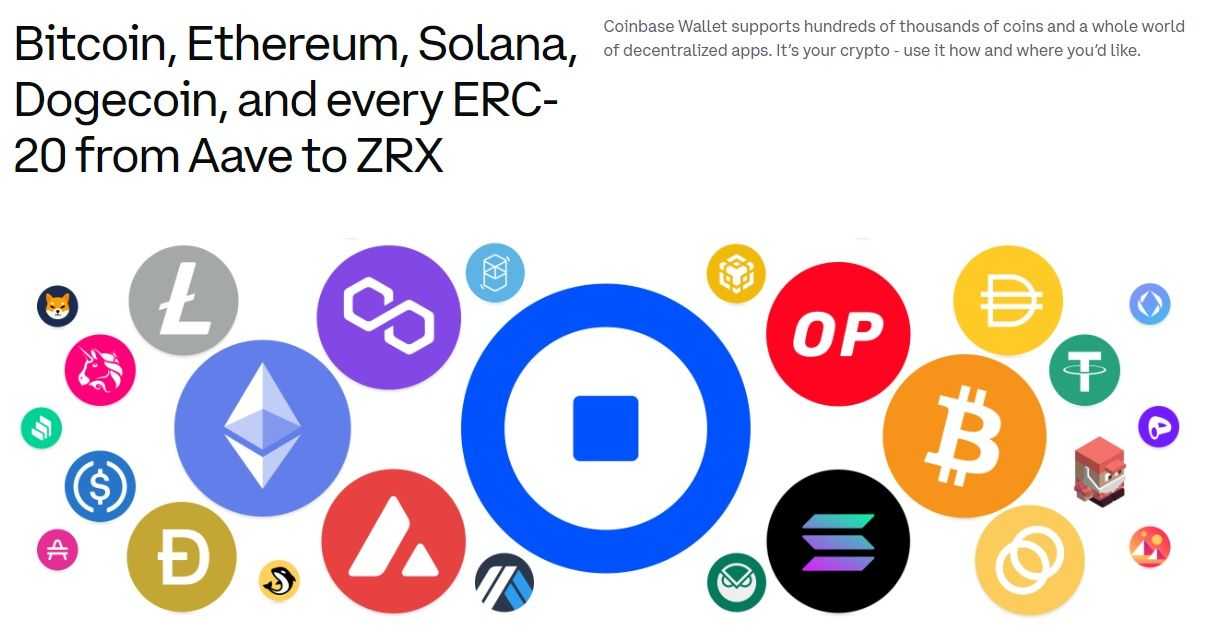
Coinbase Wallet comes with some networks already configured, and users can add other EVM-compatible networks manually. These include Arbitrum, Avalanche C-Chain, Base, BNB Chain, Gnosis Chain, Fantom Opera, Optimism, Polygon, and Solana.
For a full list of supported cryptocurrencies, users can refer to the official Coinbase Wallet support page, which provides up-to-date information on what assets are available for storage and trading.
Coinbase Wallet Security
When it comes to safeguarding your digital assets, Coinbase Wallet places a strong emphasis on security, implementing a range of features designed to protect users and their cryptocurrency holdings. Let’s explore the key security measures that make Coinbase Wallet a reliable choice for crypto storage.
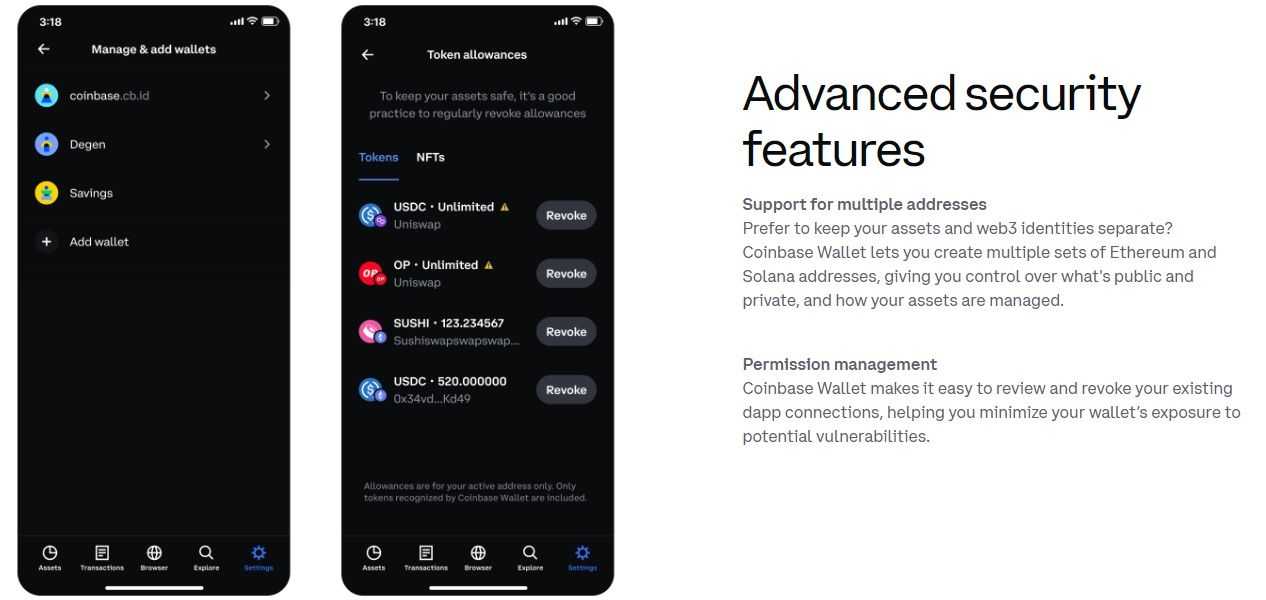
• Private Key Ownership: As a non-custodial wallet, Coinbase Wallet ensures you have full control over your private keys, which are securely stored on your device. This setup decentralizes access, so not even Coinbase can access your funds without permission.
• Biometric Authentication and Secure Enclave: Coinbase Wallet includes biometric authentication, such as fingerprint and facial recognition, adding an extra layer of security. It also uses a Secure Enclave on supported devices, providing hardware-level protection for sensitive data like private keys.
• Encrypted Backup and Recovery: The wallet allows you to store an encrypted backup of your recovery phrase on cloud services like Google Drive or iCloud, safeguarding against unauthorized access while protecting against loss of access to your funds.
• Multi-Factor Authentication (MFA): By incorporating MFA, Coinbase Wallet enhances security by requiring a secondary authentication method, making it harder for unauthorized users to access your wallet.
• Open-Source Codebase: Built on an open-source codebase, Coinbase Wallet allows for community review and auditing of its code, ensuring transparency and minimizing the risk of hidden vulnerabilities.
• Regulatory Compliance: Coinbase’s adherence to strict regulatory standards reflects its broader commitment to user safety and security across all services, including Coinbase Wallet.
Despite these robust security measures, it's important to remember that no system is entirely foolproof. Users should always practice good security hygiene, such as using strong, unique passwords and keeping their recovery phrases safe.
Coinbase Wallet’s Ledger Integration
Security is everything with your assets, digital or otherwise. For users who want an extra layer of security, Coinbase Wallet offers integration with Ledger, a well-known hardware wallet. This integration combines the convenience of Coinbase Wallet with the enhanced security of storing your private keys on a Ledger device, providing a robust solution for safeguarding your digital assets.
Before we go any further, you'd do well to check out our reviews on:
- Ledger Nano X
- Ledger Nano S Plus
- Ledger Stax
- Ledger Flex

How to Connect Your Ledger Device to Coinbase Wallet
Connecting a Ledger device to Coinbase Wallet is designed to be straightforward. Here’s how you can set it up:
1. Install the Coinbase Wallet Extension: To get started, you need to install the Coinbase Wallet extension on your desktop browser. This extension acts as a bridge between your Ledger device and the Coinbase Wallet.
2. Open the Coinbase Wallet Extension: Once installed, open the Coinbase Wallet extension on your browser.
3. Connect Your Ledger Device: With your Ledger device connected to your computer, choose “Connect Ledger Wallet” in the Coinbase Wallet extension. This action initiates the process of pairing your hardware wallet with Coinbase Wallet.
4. Select the Ledger Account: After connecting, select the Ledger account you want to use. This ensures that your digital assets are securely managed via the hardware wallet while being accessible through the Coinbase Wallet interface.
5. Authorize and Confirm: Follow the prompts on your Ledger device to authorize and confirm the connection. This step adds a layer of security, as it requires physical confirmation on the Ledger device itself, preventing unauthorized access.
Benefits of Using Ledger with Coinbase Wallet
By integrating a Ledger hardware wallet with Coinbase Wallet, users can enjoy the ease of managing their assets through the Coinbase Wallet interface while maintaining the highest level of security that Ledger provides.
- Ease of Management: Users can manage their assets through the Coinbase Wallet interface while keeping their private keys secure on the Ledger device.
- Offline Key Storage: This integration allows users to keep their private keys offline, significantly reducing the risk of hacks and unauthorized access.
- Secure Element: Ledger's secure element ensures that private keys do not leave the device, even during interactions with Coinbase Wallet or DApps.
Staking with Coinbase Wallet
Staking is one of the most popular ways to earn rewards in the world of cryptocurrency, and Coinbase Wallet makes it easy for users to participate. By staking your assets, you help secure the blockchain network and, in return, earn yield.
How to Stake with Coinbase Wallet
Staking with Coinbase Wallet is straightforward, but it’s important to note that the staking process itself doesn’t happen directly through the wallet interface. However, some staking functionalities can be accessed directly through the wallet interface. Here’s how you can get started:
- Check Your Eligibility: Not all users or assets are eligible for staking on Coinbase. To begin, you need to ensure that your account meets the eligibility requirements. Typically, this involves having a verified account and holding a minimum balance of the cryptocurrency you wish to stake. You can check your eligibility status directly in your Coinbase account under the staking section.
- Choose Your Cryptocurrency: Once you confirm eligibility, you can select from a range of supported cryptocurrencies available for staking. At this time, it appears Coinbase Wallet only supports Ethereum.
- Stake Your Assets: To stake your chosen cryptocurrency, navigate to the staking section of your Coinbase account. Follow the prompts to stake your assets, which typically involve selecting the amount you wish to stake and confirming your decision. Once staked, your assets are locked and begin generating rewards.
- Earning Rewards: After staking, you can start earning rewards based on the staking terms of the specific cryptocurrency. These rewards are usually distributed periodically, depending on the currency's cycle, and can be tracked within your Coinbase account.
- Unstaking Your Assets: If you decide you no longer want to stake your assets, Coinbase allows you to unstake them at any time. However, be aware that unstaking can take some time ranging from hours to days, depending on the network’s rules.
Coinbase Wallet’s NFT Support
Coinbase Wallet provides comprehensive support for NFTs, allowing users to store, view, and manage their digital collectibles directly within the wallet.
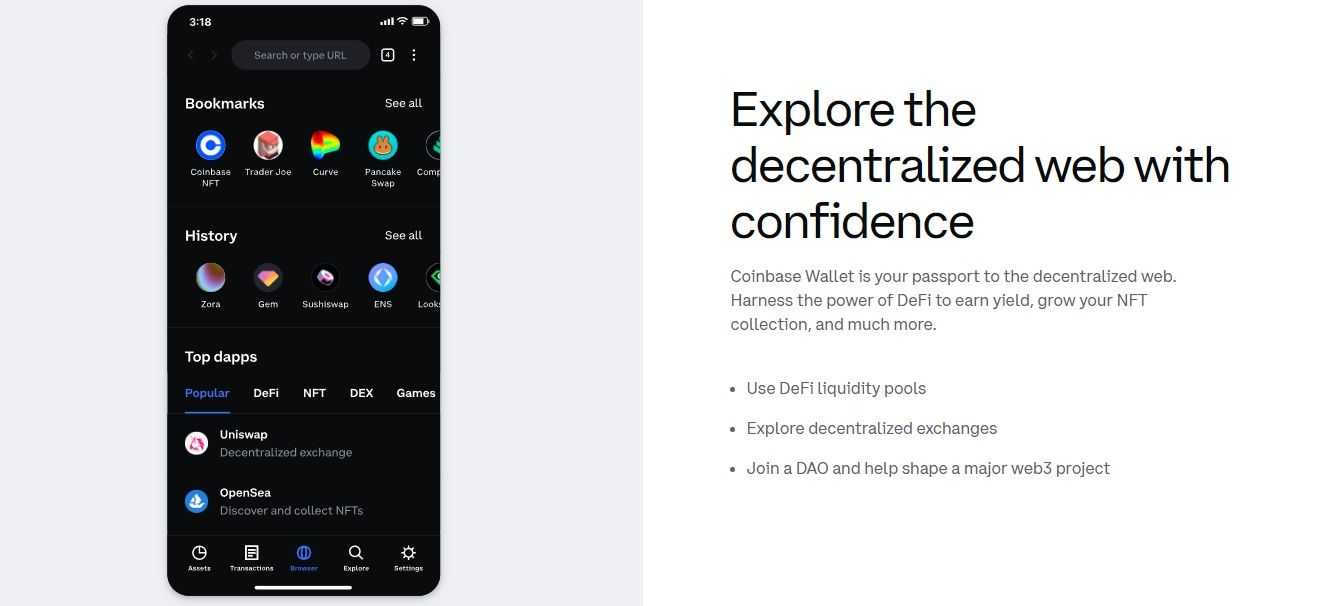
Here’s how it works:
- Storing NFTs: Once you own an NFT, you can easily store it in your Coinbase Wallet. The wallet supports a wide range of NFTs built on the Ethereum blockchain, which is currently the most popular platform for NFT creation and trading. By storing your NFTs in Coinbase Wallet, you have full control over your digital assets and can manage them securely.
- Viewing NFTs: The Coinbase Wallet app has a built-in feature that lets you view your NFTs directly in the app. This feature displays your NFTs in a visually appealing and organized way, making it easy to keep track of your collection.
- Buying NFTs: Coinbase Wallet also provides a seamless way to purchase NFTs through popular NFT marketplaces like Coinbase NFT and OpenSea. To buy an NFT, you simply connect your Coinbase Wallet to the marketplace and follow the purchase instructions.
- Using NFTs: With Coinbase Wallet, you can also use your NFTs in various ways, such as showcasing them in virtual galleries or using them in compatible games and virtual worlds.
Coinbase Wallet Review: Closing Thoughts
Choosing the right wallet for your cryptocurrency journey is about finding the perfect balance between security, functionality, and ease of use. Coinbase Wallet stands out with its robust security features, seamless integration with the Coinbase ecosystem, and support for a wide range of digital assets, including NFTs and DApps. While it may not offer all the advanced features of some competitors, it provides a reliable and user-friendly experience for managing your crypto assets.
However, remember that no two crypto users are alike. What works for one person may not work for another. When selecting a wallet, consider what features are most important to you — whether it's maximum security, ease of accessing decentralized finance, or simply managing a diverse portfolio of digital assets. Always take the time to research, understand the risks involved, and choose a wallet that aligns with your specific needs and comfort level.
Crypto can be a volatile and complex world, but with careful decisions tailored to your goals, you can navigate it safely and confidently.